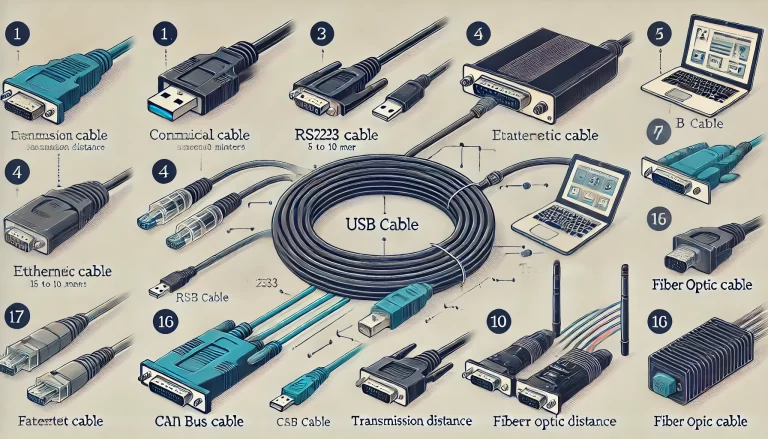In modern technology, various communication lines are used to transmit data over different distances and environments. This article explores the key types of communication lines, their features, and typical transmission ranges.
1. USB Cable
USB (Universal Serial Bus) cables are digital signal transmission lines used for connecting computers and external devices. They support both data transfer and power delivery, making them highly versatile for everyday applications.
- Common Use Cases: Charging and data transfer for devices such as smartphones, keyboards, printers, and external storage drives.
- Transmission Distance: USB cables typically support a maximum distance of around 10 meters, although this may vary depending on the USB version:
- USB 2.0: Up to 5 meters.
- USB 3.0 and above: Up to 10 meters with active repeaters or extension cables.

2. RS232, RS485, and Ethernet Cables
These communication lines are designed for longer-distance data transmission and are commonly used in industrial, commercial, and networking environments.
RS232 (Recommended Standard 232):
- An older communication standard mainly used for short-distance device-to-device communication (e.g., point-of-sale terminals or industrial sensors).
- Transmission Distance: Typically 10 to 15 meters due to limited signal strength and poor noise immunity.
RS485:
- Designed for industrial automation and control systems, RS485 is more robust than RS232, supporting multiple devices on a single network.
- Transmission Distance: Up to 1200 meters, with strong resistance to electromagnetic interference.
Ethernet:
- Ethernet cables (such as CAT5, CAT6) are used to create local area networks (LANs). They provide high-speed data transmission between computers, routers, and other network devices.
- Transmission Distance: Standard Ethernet cables can support up to 100 meters without signal degradation. Fiber-optic extensions may be used for longer distances.
3. CAN Bus Cable
The CAN (Controller Area Network) bus is a robust communication protocol designed for automotive and industrial applications. It allows devices, such as electronic control units (ECUs), to exchange information in real time.
- Key Features: High reliability, fault tolerance, and synchronization.
- Transmission Distance: Depending on the baud rate (transmission speed), the distance can range from 40 meters to 10 kilometers. Lower baud rates allow for longer distances, while higher baud rates are suited for short, high-speed communication.

4. Single-Mode and Multi-Mode Fiber Optic Cables
Fiber optic cables use light signals to transmit data, offering extremely fast speeds and minimal signal loss. These cables are commonly used in high-speed networks and long-distance communication.
Single-Mode Fiber:
- Ideal for long-distance transmission, single-mode fiber has a narrow core that minimizes light dispersion.
- Transmission Distance: Can reach tens to hundreds of kilometers with appropriate equipment.
Multi-Mode Fiber:
- Designed for shorter distances, multi-mode fiber has a wider core that allows multiple light paths. However, this leads to greater signal dispersion and shorter transmission ranges.
- Transmission Distance: Typically 2 to 5 kilometers, often used in campus or data center networks.
Conclusion
Understanding the communication distances and capabilities of different transmission lines is crucial for selecting the right technology for your application. USB cables excel in short-distance, high-speed data transfer; RS232 and RS485 are reliable for industrial communication; Ethernet is the backbone of local networks; CAN bus serves specialized automotive needs; and fiber optics offer unparalleled speed for long-distance data transmission.
